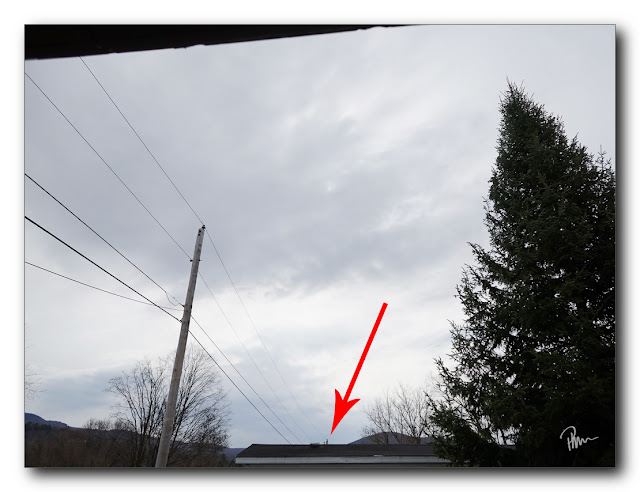Comparing Lens Field of View
Whenever I post some photos here of songbirds, ducks, loons, any wildlife as well as the moon, I know that few will understand the distances involved. I also know that few will understand many of the terms I use pertaining to these lenses.
After capturing some images of the moon last night, I thought it would be a good idea to get a couple of comparison images to show here. In this first image we see a fairly wide view... the red arrow is pointing to an insulator on a utility pole which is just peaking above the rooftops....
 |
| Just barely visible above this rooftop is an insulator on top of a distant utility pole... |
For the second image, I shot a photo using my longest lens... a 600mm lens... of course, I understand that saying a focal length of such-and-such "mm" means nothing to most people which is why I am posting this comparison for everyone to see. These comparison photos help to picture the difference between focal length in millimeters. What may be more useful for some people is to say that this view is zoomed approximately 25 times in magnification compared to the top image... the correct way to describe this, however, is by using the standard, full-frame focal length in millimeters.
 |
| Here is the insulator from the above photo captured using a super-telephoto lens at 600mm. |
I use this 140-600mm lens for most of my wildlife shots and all of my moon shots. It is not the greatest of lenses so I also use a 90-400mm lens for wildlife. The 90-400mm lens is a better quality lens with better autofocus than the longer 140-600mm lens but its reach is lacking for skittish wildlife. I've also used the longer 140-600mm lens for all of the distant sailing action shots of Adam on the sailboat while I sat comfortably on shore. In good light, I can get some nice photos with this longer lens.
I should also mention that shooting at 600mm is extremely difficulty because any tiny movements of the lens will move your subject right out of your viewfinder by dozens of feet! If you are not rock steady, your subject will continuously bounce in and out of your view, in constant motion. It takes a lot of practice to keep the camera and lens steady enough to get crisp photos.
Small songbirds... like sparrows, finches, and chickadees... must be much closer than you would think even when you have a 600mm lens. For this shot below, I was in the 30-40 foot range... that is close yet I still needed a 600mm focal length to get this shot...
 |
| A 600mm lens at approximately 30 feet... lots of nice detail... with some blurred branches in the foreground making focus difficult. |
Larger birds... such as loons... can be much farther away but you still want to get as close as possible for a number of reasons. This loon, below, was in the range of about 125-150 feet and I still had to crop the image so I could zoom into this bird a bit more. Cropping, however, is a last resort method of zooming because image quality deteriorates very quickly and very easily.
What made this loon photo the most difficult, however, wasn't the distance. The biggest obstacle was the lack of light since the sun had already dropped below the horizon when I shot this photo. The closer you can get, physically, the more detail you will capture... plus, good light is essential.
 |
| This loon was in the shadows of dusk upwards of 150 feet away... I used my 600mm lens but would have preferred an 800mm lens! |
Those first two photos, above, do a good job at showing how much a 600mm lens can magnify your view. The bigger and longer the lens, however, the more difficult it is to keep everything steady enough to shoot crisp photos!
This is why I practice whenever I have a few moments.
Comments
Post a Comment